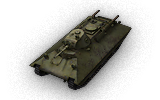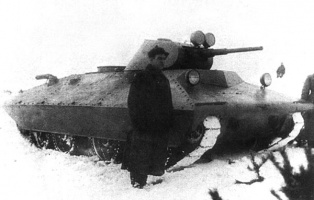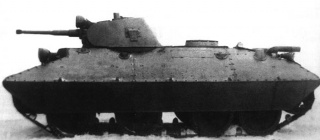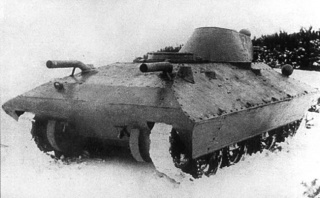BT-SV
BT-SV (Stock)
| 1000 Coût |
| 360 PSDurabilité |
| 13.11 / 14.5 Poids |
- Chef de char
- Chargeur
- Opérateur radio
- Pilote
- Tireur
| 25/20/16Blindage caisse(avant/flancs/arrière, mm) |
| 25/25/25Blindage tourelle(avant/flancs/arrière, mm) |
| 500 chPuissance moteur |
| 62 km/hVitesse maximale / en marche arrière |
| 40 °/sVitesse de rotation |
| 55 damage |
| 51 mmPénétration moyenne |
| 4 Temps pour un chargement complet |
| 39 °/sVitesse de rotation du canon |
| 210 mPortée de vue |
| 500 mPortée du signal radio |

It was available on the Russian Portal in the Russian Gift Box edition as well as in a special Gift Box edition along with the MTLS-1G14, Pz.Kpfw. II Ausf. J and SU-85I. The enclosed code was valid for use on the RU, EU, NA and SEA servers.


Tourelle
| Niveau | Tourelle | Blindage tourelle (avant/flancs/arrière, mm) | Vitesse de rotation du canon (°/s) | Portée de vue (m) | Expérience | Poids (t) |
|---|---|---|---|---|---|---|
| IV | BT-SV | 25/25/25 | 39 | 210 | 0 | 400 |
| Niveau | Canon | Pénétration moyenne (mm) | Cadence de tir | Dispersion à 100 m | Temps de visée | Expérience | Poids (t) | |
|---|---|---|---|---|---|---|---|---|
| II | 45mm 20KL | 51/84/12 | 55/55/75 | 15 | 0.41 | 1.7 | 0 | 250 |

Moteur
| Niveau | Moteur | Puissance moteur (ch) | Probabilité d'incendie à l'impact | Expérience | Poids (t) |
|---|---|---|---|---|---|
| IV | M-17FO | 500 | 20 | 0 | 610 |

| Niveau | Suspension | Limite de charge | Vitesse de rotation (°/s) | Expérience | Poids (t) |
|---|---|---|---|---|---|
| III | BT-SV | 14.5 | 40 | 0 | 2000 |

Radio
| Niveau | Radio | Portée du signal radio (m) | Expérience | Poids (t) |
|---|---|---|---|---|
| III | _71-TK-3_USSR | 500 | 0 | 100 |
Compatible Equipment
Compatible Consumables
Avis des joueurs
Points forts/faibles
Points forts :
- Very fast acceleration
- Heavily angled armor provides decent protection
- Never sees tier 5 tanks
- Side skirts help protect against HE
Points faibles :
- Poor turning speed
- Below average penetration
- Very poor view and radio range
- Poor gun depression
Performance
This tank, with regards to the high speed, well-sloped armor, the fact that it never sees Tier 5's on top of the generally poor skills of lower-tier pub match players, this is arguably one of the most fun tanks in the whole game. Thanks to the rocket-like speed, ramming targets as a last resort is a possibility, though it is probably not recommended as you won't survive. One of the ways this tank is best played is to do a drive-by on a group of enemies, using your combination of excellent speed and sloped armor to survive as you throw shots downrange. Another viable option is to use your speed to get to good positions, allowing you to claim an area before the other team has a chance. The gun itself isn't too bad either, even if it is under par in some areas like depression. While it may have incredible acceleration and top speed, it comes at a price; its turning speed is abysmal. This means you should think ahead so you don't find your tank plummeting off a cliff or straight into another tank.
Modules prioritaires
Premium tank, none required
Informations Historiques
Christie, a race car mechanic and driver from New Jersey, had tried unsuccessfully to convince the U.S. Army Ordnance Bureau to adopt his Christie tank design. In 1930, Soviet agents at Amtorg, ostensibly a Soviet trade organization, used their New York political contacts to persuade U.S. military and civilian officials to provide plans and specifications of the Christie tank to the Soviet Union. At least two of Christie's M1931 tanks (without turrets) were later purchased in the United States and sent to the Soviet Union under false documentation in which they were described as "agricultural tractors." Both tanks were successfully delivered to the Kharkov Komintern Locomotive Plant (KhPZ). The original Christie tanks were designated fast tanks by the Soviets, abbreviated BT (later referred to as BT-1). Based both on them and on previously obtained plans, three unarmed BT-2 prototypes were completed in October 1931 and mass production began in 1932. Most BT-2s were equipped with a 37 mm gun and a machine gun, but shortages of 37 mm guns led to some early examples being fitted with three machine guns.
The sloping front hull (glacis plate) armor design of the Christie M1931 prototype was retained in later Soviet tank hull designs, later adopted for side armor as well.
The most important legacy of the BT tank was the T-34 medium tank, arguably the most important tank of World War II. In 1937, a new design team was formed at the KhPZ to create the next generation of BT tanks. Initially, the chief designer was Mikhail Koshkin and, after his death, Morozov. The team built two prototypes. The light one was called the A-20. The more heavily armed and armoured BT derivative, the A-32, was a "universal tank" to replace all the T-26 infantry tank, BT cavalry tanks, and the T-28 medium tanks. Such a plan was controversial, but concerns about tank performance under the threat of German blitzkrieg led to the approval for production of a still more heavily armoured version, the T-34 medium tank.
Along the way, an important technical development was the BT-IS and BT-SW-2 testbed vehicles, concentrating on sloped armour. This proof-of-concept led directly to the armour layout of the T-34.
Historical Gallery
Sources et Liens Externes
| Light Tanks | |
| Medium Tanks | |
| Heavy Tanks | |
| Tank Destroyers | |
| Self-Propelled Artillery |
| USA | |
| UK | |
| Germany | |
| USSR | |
| China | |
| Japan |


